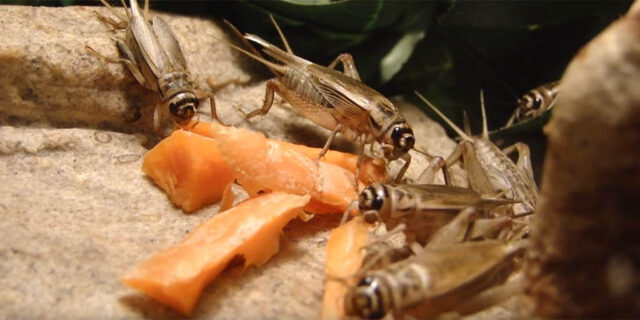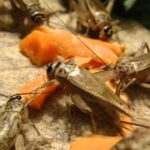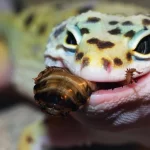Feeding crickets to Leopard geckos is essential for keeping these fascinating reptiles healthy and happy. Crickets are one of the main food sources for Leopard geckos and other insect-eating lizards because they provide many of the nutrients these reptiles need. Packed with protein, carbohydrates, fats, minerals, vitamins, and water, crickets are a convenient and nutritious choice.
Table of Contents
Introduction to Feeding Crickets to Leopard Geckos
The average nutritional composition of a well-fed cricket includes approximately 21% protein and 6% fat. This nutrient balance makes crickets a valuable food option for Leopard geckos. Additionally, crickets are easy to breed and practical to manage, which makes them one of the top choices for feeder insects in the reptile-keeping community.
Cricket Sizes: Choosing the Right Size for Your Leopard Gecko
Leopard geckos require crickets that are appropriately sized for their age and size. A general rule to follow is that the cricket should be no larger than the space between the Leopard gecko’s eyes. If a cricket is too large, it could pose a choking hazard or cause digestive issues.
Commercially available crickets come in various sizes, including large, medium, small, and pinhead. Pinhead crickets are very small and wingless, ideal for baby Leopard geckos or hatchlings. These tiny crickets measure about the size of a pinhead, making them manageable for young geckos to consume safely.
Small crickets are slightly larger and are suitable for juvenile geckos, measuring a few millimeters in length. As Leopard geckos grow, they can be fed medium-sized crickets, which are around 1 cm (0.4 inches) long. Fully-grown Leopard geckos can handle large crickets, which can reach 2–3 cm (0.8–1.2 inches) in length depending on the species.
Selecting the Correct Crickets for Leopard Geckos
Selecting high-quality crickets is important to ensure that your Leopard gecko receives optimal nutrition. It is recommended to buy crickets from reputable breeders or pet stores to avoid any risk of disease or contamination. Fresh, well-fed crickets are more nutritious and likely more appealing to your gecko.
In addition to size, consider the quality of the crickets. Fresh crickets that have been recently gut-loaded with nutritious foods (like vegetables and grains) are better than crickets that have been sitting for days without proper food. Quality crickets will offer a more balanced diet and reduce the risk of health issues.
Determining How Many Crickets to Feed
When feeding crickets to your Leopard gecko, quantity matters. Offer only the number of crickets your gecko can eat within 10–20 minutes. The exact number will depend on the size and age of your Leopard gecko, the size of the crickets, and the frequency of feedings. Younger geckos or smaller individuals might consume just one or two crickets, while adults may eat up to a dozen.
It’s best to avoid leaving uneaten crickets in the enclosure, as they may stress your Leopard gecko or even bite it, causing small injuries. Remove any leftover crickets after mealtime to maintain a safe environment for your pet.
Cricket Species: Which Ones to Feed?
Different cricket species are available as feeder insects, and each has its benefits. Two commonly fed cricket species include:
- European House Cricket (Acheta domestica): Also known as the grey cricket, this species is high in protein and provides a balanced energy source.
- Common Black Cricket (Gryllus bimaculatus): Known for its larger size and nutritional content, this cricket is also a popular choice among reptile keepers.
Both types are soft-bodied, making them easier for Leopard geckos to digest. They are also more proliferous and softer than many other feeder insects, such as cockroaches, and can be easily dusted and gut-loaded.
Gut-Loading Crickets for Enhanced Nutrition
Gut-loading is an essential step to boost the nutritional value of crickets before feeding them to Leopard geckos. This involves feeding the crickets a nutrient-rich diet for 24 to 48 hours prior to offering them to your gecko. Vegetables, grains, and high-calcium foods are excellent gut-loading options.
Crickets naturally have a low calcium-to-phosphorus ratio (approximately 1:12), which is not ideal for Leopard geckos. By gut-loading with high-calcium foods, you help improve this balance. Additionally, dusting crickets with a calcium supplement 2–3 times per week is recommended, ensuring that your Leopard gecko receives adequate calcium for bone health and growth.





